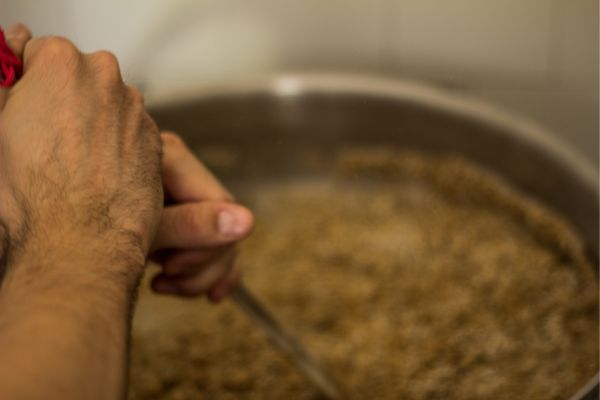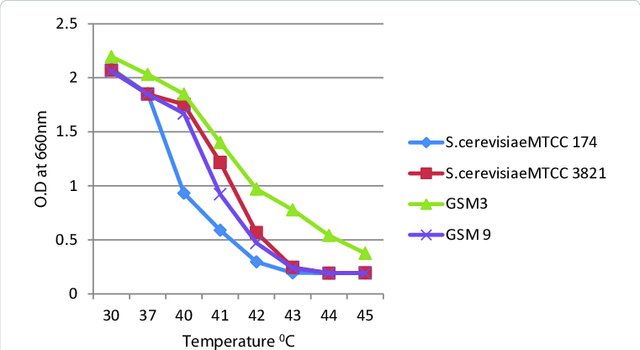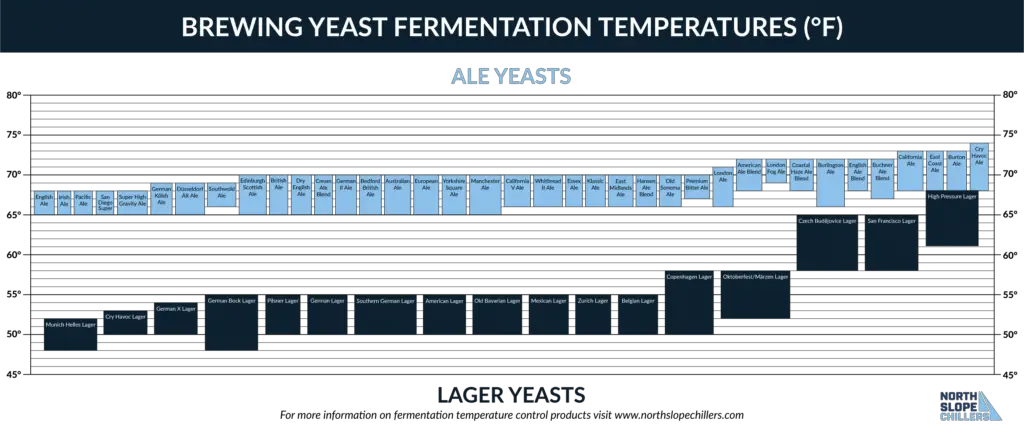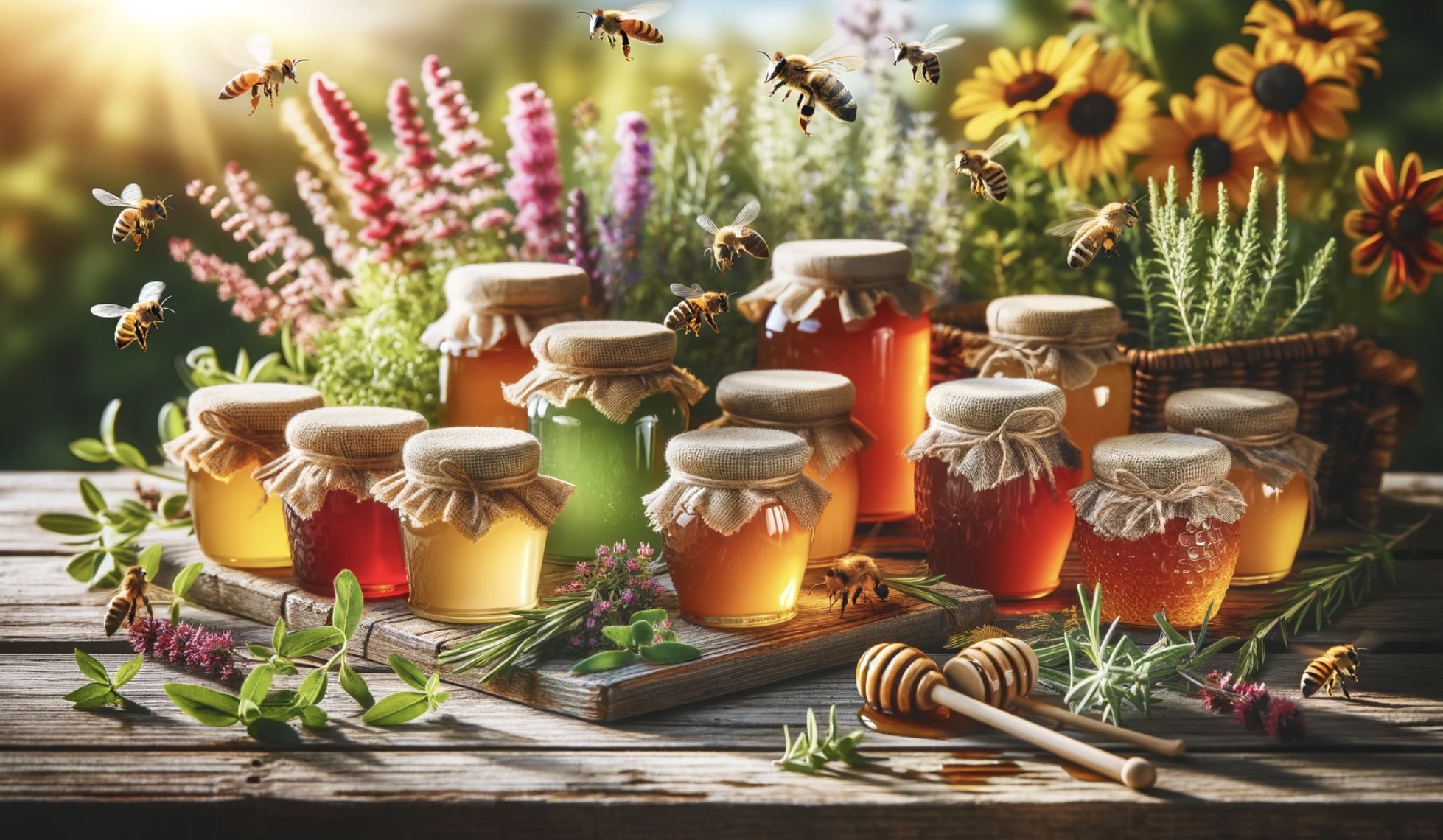The answer lies in the selection of yeast strains and beer styles that are tolerant to higher fermentation temperatures.
From my personal experience, certain styles of beer, such as Saisons and Belgian Ales, along with specific yeast strains like, Norwegian Kveik, Brettanomyces and Saccharomyces cerevisiae var. diastaticus, are suitable for fermenting at higher temperatures.
Ales over lagers – Ales Are Brewed at High Temperatures
Ales and lagers are two primary categories of beer, and they are distinguished primarily by the type of yeast used for fermentation and the temperatures at which they are fermented.
Let’s explore these differences in more depth:
Ales:
- Yeast: Ales are brewed using a type of yeast known as Saccharomyces cerevisiae. This yeast is top-fermenting, meaning it ferments at the top of the fermentation vessel.
- Fermentation Temperature: Ales are typically fermented at warmer temperatures, ranging from 60°F to 72°F (15°C to 22°C), though some can go even higher.
- Why Higher Temperatures for Ales?
- Yeast Characteristics: The ale yeast strains are adapted to ferment best at these warmer temperatures. At these ranges, ale yeasts produce a variety of aromatic compounds, which impart fruity and estery flavors to the beer. These flavors are often desired in ales, contributing to their complexity and depth.
- Faster Fermentation: Warmer temperatures generally speed up fermentation, which means ales can be brewed and ready for consumption faster than lagers.
- Flavors and Styles: Because of the fermentation characteristics, ales can have a broad spectrum of flavors, ranging from sweet and fruity to bitter or spicy. Some popular ale styles include India Pale Ale (IPA), stout, porter, and Belgian Tripel, among many others.
Lagers:
- Yeast: Lagers are brewed using a yeast known as Saccharomyces pastorianus. This yeast is bottom-fermenting, meaning it tends to ferment at the bottom of the fermentation vessel.
- Fermentation Temperature: Lagers ferment at cooler temperatures, typically between 44°F to 55°F (7°C to 13°C).
- Flavors and Styles: Lagers are often described as having cleaner, crisper, and more mellow flavors than ales. This is due to the cooler fermentation temperatures which suppress the production of esters and other aromatic compounds that are prominent in ales. Some popular lager styles include Pilsner, Helles, and Dunkel.
Ale and Lager Fermentation Temperature:
Fermentation temperature plays a crucial role in the final flavor profile of the beer. The reason ales are brewed at higher temperatures is largely tied to the biology of the yeast strains used.
Each yeast strain has an optimal temperature range where it performs best, producing alcohol efficiently while also generating the desired balance of flavor compounds.

Using the correct temperature range for the chosen yeast ensures the beer develops the right balance of flavors, aromatics, and alcohol content.
In conclusion, the distinction between ales and lagers is primarily based on the yeast type and fermentation temperature. These differences lead to the wide variety of beer styles and flavors enjoyed by enthusiasts around the world.
Whether one prefers the fruity and complex notes of an ale or the clean and crisp profile of a lager, there’s a beer out there for every palate!
Saisons
Saisons are a popular style of beer that are known for their ability to ferment at higher temperatures.
Originating from Belgium, saisons were traditionally brewed in farmhouses during the winter months and then stored for consumption in the summer. Because of this, they were often fermented at higher temperatures, typically ranging from 68 to 85°F (20 to 29°C).
The yeast strain that is commonly used for Saisons is Saccharomyces cerevisiae var. diastaticus. This yeast strain is known for its high attenuation and ability to ferment at high temperatures, producing complex flavors of pepper, spice, and fruit.
From my personal experience, brewing Saisons at high temperatures can actually enhance these flavors, creating a unique and refreshing beer that is perfect for warm summer days.
Belgian Ales
Another style of beer that is well-suited for high temperature fermentation is Belgian Ales. Belgian Ales are known for their strong character, with flavors ranging from fruity to spicy. They are typically fermented at temperatures ranging from 68 to 78°F (20 to 25°C).
The yeast strain used in brewing Belgian Ales is often Saccharomyces cerevisiae, which thrives at these higher temperatures.
This yeast strain produces a variety of esters and phenols that contribute to the complex flavor profile of Belgian Ales.
In my own brewing experience, I have found that fermenting Belgian Ales at higher temperatures can bring out these flavors, resulting in a beer with a rich, full-bodied taste.
Brettanomyces
When it comes to yeast strains that can handle high temperatures, Brettanomyces is one that stands out. This strain is known for its ability to ferment at temperatures up to 85°F (29°C), and for producing beers with a unique and complex flavor profile.
Brettanomyces is often used in the brewing of Belgian Lambics and American Wild Ales. These beers are characterized by their sour, funky flavors, which are only enhanced by the high fermentation temperatures.
In my experience, brewing with Brettanomyces can be a bit of a wild card, as the flavors produced can vary greatly. However, this also makes it an exciting yeast to work with, as the end result can be quite rewarding.
High Gravity, High Temperature Beers
High gravity beers, or beers with a high original gravity, can also benefit from high temperature fermentation.
These beers, which include styles like Barleywines, Imperial Stouts, and Belgian Tripels, often require a strong fermentation to fully attenuate the high amount of sugars present in the wort.
In my experience, brewing high gravity beers at high temperatures can help to ensure a thorough and complete fermentation. However, it’s important to note that the yeast strain used must be able to handle the high alcohol content that these beers produce.
Yeast Strains For High Temperature Brewing
There are many high-temperature yeast strains to choose from, but here are some of the best based on my personal experience and widespread use in the brewing community:
1. Lallemand Voss Kveik Ale Yeast
Lallemand Voss Kveik Ale Yeast is a traditional dried yeast that has been used in Norwegian farmhouse brewing for generations.

It is perhaps the yeast strain with the highest temperature range of brewing yeasts.
And it is really one of my favorite beer yeast strains of all time, which is why I have dedicated most of this article to the Kveik yeast (make sure to read detailed walkthrough of Kveik later in this article!).
This yeast supports a wide, but very high, range of fermentation temperatures between 25-40°C (77-104°F) with a very high optimal range of 35-40°C (95-104°F).
The LalBrew Voss™ strain was obtained from Sigmund Gjernes (Voss, Norway), who has maintained this culture using traditional methods since the 1980s and generously shared it with the wider brewing community.

Very fast fermentations are achieved within the optimal temperature range with full attenuation typically achieved within 2-3 days.
The flavor profile is consistent across the entire temperature range: neutral with subtle fruity notes of orange and citrus.
The ability to ferment at high temperatures makes Lallemand Voss Kveik Ale Yeast an excellent choice for brewers looking to produce beer quickly, especially in warmer climates.
Additionally, its high flocculation produces clear beers.
Overall, Lallemand Voss Kveik Ale Yeast is a versatile and reliable yeast that can produce excellent results in a variety of brewing conditions.
See more at Lallemands homepage.
2. Wyeast 1388
This strain has an ideal fermentation temperature range of 64-80°F (18-27°C). It’s a liquid beer Yeast isolated from traditional Belgian Strong Ale – so Wyeast 1388 is another good option if brewing high gravity Belgian ale beers, especially Golden Strong Ales. It can tolerate up to about 12-13% ABV.
3. Fermentis SafAle US-05
Fermentis SafAle US-05 is a versatile brewer’s yeast for neutral ales. It is an American ale brewer’s yeast that produces neutral and well-balanced ales, clean and crispy.

It forms a firm foam head and presents a very good ability to stay in suspension during fermentation.
It is ideal for American beer types and highly hopped beers. According to Fermentis, the ideal temperature range for using SafAle US-05 is 18-28°C (64-82°F), but according to 3rd party (home brewer) tests, it ferments optimally at 28C and is still quite good until around 34C.
4. Lalvin EC-1118 all-around yeast
Lalvin EC-1118 produced by Lallemand Brewing is a robust and reliable yeast strain that is known for its neutral sensory contribution to wine.

It is used extensively in the world for the production of both white and red wines, and is highly recommended for secondary fermentation.
According to Lallemand Brewing, the desirable fermentation temperature range for Lalvin EC-1118 is 10-30°C (50-86°F).
5. Mangrove Jack’s M42
Mangrove Jack’s M42 New World Strong Ale Yeast is a top-fermenting ale strain suitable for many types of ales of all strengths.

It ferments with a neutral yeast aroma to ensure the full character of the malts and hops are prominent in each beer. This strain has an optimal temperature range of 16-28°C (61-82°F).
For best results, it is recommended to ferment at 16-22 degrees C (61-72 degrees F), but in my experience it works well up to around 30C (86F).
It is suitable for IPA’s, Porters, Russian Imperial Stouts and more. Its high attenuation (77 – 82%) and very high flocculation make it a great all-around workhorse for beer brewing.
Understanding High-Temperature Yeast Strains
While “ordinary” yeast strains typically ferment best at temperatures ranging from 15°C to 24°C (59°F to 75°F), they do not actually die off before the late 30C or around 40C (104F).
After that they pretty much stop growing:

High-temperature yeast strains, most often being ale yeast, are able to ferment at warmer temperatures without producing off-flavors.
Ale and lager yeasts: The highs and lows of fermentation temperature optimums!
Ale and lager yeast are two distinct strains of yeast commonly used in the brewing industry to produce different types of beer.

They differ not only in terms of the flavors they impart but also in their optimal fermentation temperatures and the reasons behind these differences.
Ale Yeasts:
- Ale yeast, most being Saccharomyces cerevisiae, is a top-fermenting yeast strain. It ferments at warmer temperatures compared to lager yeast.
- Optimal fermentation temperature for ale yeast typically ranges from 60°F to 75°F (15°C to 24°C). Some ale yeast strains may even tolerate slightly higher temperatures.
- The warmer fermentation temperatures associated with ale yeast lead to a faster fermentation process. This results in a beer with a quicker turnaround time, often ready to drink in a matter of weeks.
- Ale yeast produces a wider range of flavors and aromas, including fruity esters and spicy phenols, which contribute to the complex and diverse flavor profiles found in ales. These flavors are often more pronounced due to the higher fermentation temperatures.
Lager Yeasts:
- Lager yeast, scientifically known as Saccharomyces pastorianus, is a bottom-fermenting yeast strain. It ferments at cooler temperatures compared to ale yeast.
- Optimal fermentation temperature for lager yeast typically ranges from 45°F to 55°F (7°C to 13°C). Some lager yeast strains may require even cooler temperatures, especially for traditional lager styles.
- The colder fermentation temperatures associated with lager yeast result in a slower fermentation process. Lager beers often require a longer maturation period, sometimes several months, to reach their optimal flavor.
- Lager yeast produces fewer esters and phenols compared to ale yeast. This results in a cleaner and crisper flavor profile with a focus on malt and hops characteristics. Lager beers are known for their subtlety and balance.
The Kveik Yeasts: Thermophile Yeasts From The Cold North!
In the world of brewing, one of the most intriguing yeasts, gaining popularity in recent years, has been the remarkable kveik yeasts, a group of yeast strains originating from the cold Scandinavian country of Norway.

What’s truly fascinating about these yeasts is their incredible ability to thrive and ferment at high temperatures, a trait that might seem ironic considering their Nordic origins.
Origin and Evolution of Kveik Yeasts
Kveik yeasts have a rich history deeply rooted in Norwegian and Scandinavian brewing traditions. Historically, these yeasts were used in traditional farmhouse brewing practices.
Brewers in these regions would pitch kveik yeast into warm, strong wort, often exceeding 30ºC (86ºF), and store the yeast for extended periods between brewing sessions, sometimes up to a year.
This unique brewing environment, with its high-temperature fermentation and prolonged storage, laid the foundation for the evolution of kveik yeasts.

Contrast this with modern commercial brewing practices, where American Ale yeasts like the well-known ‘Chico’ (SafAle US-05) are often repitched into relatively cool and standard strength wort, typically around 18-20ºC (64-68ºF).
The differences in temperature and usage over many generations have likely led to distinct adaptations in kveik yeasts compared to their American Ale counterparts.
Adaptation to High Temperatures
Recent research has shed light on the remarkable temperature adaptability of kveik yeasts.
Several kveik strains, including Lalbrew Voss, Omega Lutra, and Escarpment Laerdal, were subjected to a range of fermentation temperatures, from moderate to extremely high.
The results provide valuable insights into how these yeasts perform and adapt at various temperature regimes.
Figures 1 and 2 (panel C) from the research (see below) illustrate the fermentation performance of Lalbrew Voss kveik at different temperatures.

It’s evident that temperature significantly influences the fermentation properties of Voss kveik. Notably, the triplicate ferments at 33.5ºC and 37ºC exhibit the fastest fermentation rates, reaching terminal gravity in remarkably short timeframes (less than 40 hours!).
In contrast, the 20ºC ferment is notably slower, and the 42ºC ferment is even slower than the 28ºC one. This data indicates that Voss kveik is inhibited at temperatures of 40ºC and above.

Figure 2 highlights the maximum fermentation rate for Voss kveik at various temperatures, showing that the optimum temperature for this yeast strain is around 37ºC. This aligns with our earlier research, confirming that kveik yeasts indeed thrive at elevated temperatures.
Surprisingly, the apparent attenuation of Voss kveik remained consistent across the temperature gradient, hovering around 77% from 20ºC to 42ºC.
This stability in attenuation is noteworthy, as other yeasts, such as Lutra and Laerdal kveik, show decreased attenuation at higher temperatures due to temperature-induced stress.
Tips for Brewing at High Temperatures
While brewing at high temperatures can offer some benefits, it’s important to keep in mind some tips to ensure a successful brew.
Firstly, it’s crucial to select a yeast strain that can handle the high temperatures. Secondly, proper aeration of the wort is critical as yeast requires more oxygen at higher temperatures. Lastly, monitoring the fermentation process closely is key.
In my experience, paying attention to these factors can make the difference between a good beer and a great one.
Conclusion
In conclusion, there are a variety of good beers that can be fermented at high temperatures.
Styles such as Saisons and Belgian Ales, along with yeast strains like Brettanomyces and Saccharomyces cerevisiae var. diastaticus, are well-suited for high temperature fermentation.
Fermenting at high temperatures can enhance the complex flavors of these beers, resulting in a unique and refreshing product. However, it’s important to select a suitable yeast strain and monitor the fermentation process closely to ensure a successful brew.
10 Facts about High Temperature Fermentation
1. Saisons and Belgian Ales are well-suited for high temperature fermentation.
2. Brettanomyces and Saccharomyces cerevisiae var. diastaticus are yeast strains that can handle high temperatures.
3. High gravity beers can benefit from high temperature fermentation.
4. Proper aeration of the wort is critical when brewing at high temperatures.
5. High temperature fermentation can enhance the complex flavors of certain beer styles.
6. The typical fermentation temperature range for Saisons is 68 to 85°F.
7. The typical fermentation temperature range for Belgian Ales is 68 to 78°F.
8. Brettanomyces is often used in the brewing of Belgian Lambics and American Wild Ales.
9. Saccharomyces cerevisiae produces a variety of esters and phenols that contribute to the complex flavor profile of Belgian Ales.
10. High gravity beers require a strong fermentation to fully attenuate the high amount of sugars present in the wort.
From my personal brewing experience, I have found that embracing the constraints of high temperature fermentation can lead to some truly unique and delicious beers.
So, don’t let a lack of temperature control hold you back from brewing! There are plenty of good beers to ferment at high temperatures.
FAQs
Which style of beer requires top fermenting yeast and warmer temperatures?
A style of beer that requires top fermenting yeast and warmer temperatures is known as ale.
Are lagers top fermenting beers?
No, lagers are not top-fermenting beers.
Which beer has top-fermenting yeast?
Ales are the type of beer that typically use top-fermenting yeast.
Is ale yeast top-fermenting?
Yes, ale yeast is a top-fermenting yeast.
Is top fermentation used to make lager?
No, top fermentation is not used to make lager.
What beers are made by the top-fermenting process?
Beers that are made using the top-fermenting process include ales, such as pale ales, India pale ales (IPAs), stouts, porters, wheat beers, and Belgian-style ales.




